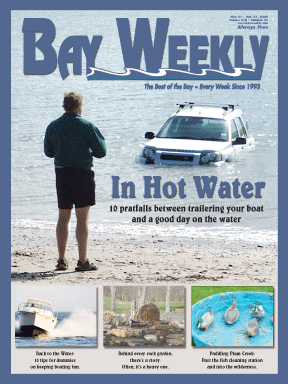
Volume XVII, Issue 21 # May 21 - May 27, 2009 |
 |
 |
|
Living in and challenging the mighty surf of the North Atlantic, our Chesapeake-born fish will become even more powerful.
|
Rockfish Graduation
Now they are ocean dwellers
Spring is waning, summer is approaching and once again things are changing in the Chesapeake. The rockfish spawning run is just about over. A few late starters will still be arriving and traveling to their natal waters to deposit their eggs and milt until early June, but most have already accomplished their mission.
The big migratory rockfish are returning to their life at sea while our locals, having spawned as well, are beginning to school and start another summer cycle in the Chesapeake. But not all of them.
Many of the rockfish that have called the Chesapeake their home for the last four or five years — fish that have been nurtured in our Bay waters since birth and grown bigger and stronger on a rich diet of menhaden, crabs, perch and spot — have changed another way. They are ready to graduate and leave home.
Hearing, at last, the primordial siren song of the wild Atlantic, these Tidewater-born babies are grown up and ready to head out into the great unknown. These fish will form into loose schools after their spawn and begin traveling south toward the ocean for the first time. They are beginning an epic journey that we can only begin to imagine.
When they reach the distant mouth of the Bay, they will turn north. Some will travel as far up the coast as Nova Scotia and even into the St. Lawrence, but most will pause somewhere just off our eastern states. Now they are ocean dwellers.
Ranging the northeastern seaboard and feeding up all summer, they will grow and become even more powerful, living in and challenging the mighty surf of the North Atlantic. Eventually, in the coming fall months, a different urge will begin and they will join their other migratory brethren, following enormous schools of baitfish heading south toward warmer waters.
Some of our Chesapeake-born stripers will choose to venture down the coast as far as Florida and even into the Gulf of Mexico, though most will reach waters no more southern than those of North Carolina. They will cruise in their chosen areas all winter long, feeding up on the massive wintering schools of baitfish.
At the end of the winter months, ever growing and increasing in strength, they will be beckoned by spring and Mother Nature. The urge to reproduce becoming overwhelming, they will return to us and their birthplace, the Chesapeake Bay, once again.
Fish Are Biting
The rockfish trophy season is over. The minimum size limit for stripers is now 18 inches with the possession limit raised to two fish (only one of which can exceed 28 inches). Only the main stem of the Bay is legal for taking fish — until June 1, when the tributaries will be open as well. A few big ocean-run stripers may still be moving through, but most of the migratory fish have spawned out and left for saltier waters.
Trolling may be the most effective means to find the new season’s bigger fish, but it will soon become less productive than other techniques. Our resident rockfish are forming together in large schools, usually at the mouths of the tributaries. Chumming, chunking and bait fishing near these areas are starting to produce good results; jigging and live lining will soon begin to be effective as well.
Be sure to use circle hooks, especially when chumming and bait fishing and always for catch and release. Avoid deep-hooking undersized rock.
Nice-sized croaker have been taken as far north as Matapeake Fishing Pier and Sandy Point State Park, with the bite in full swing down south at Hoopers, Crisfield and Point Lookout. The best fishing for croaker is at night. Their numbers will grow rapidly here in the mid-Bay as schools of these fish arrive from their wintering grounds off the Atlantic coast.
White perch are beginning to school in Bay waters as well; find them hanging out around piers and most rocky structures. Spot have not arrived yet but should be arriving sometime in the next couple of weeks.
The freshwater fishing all over Maryland has become blazing hot. Largemouth bass are showing well in the shallows, taking top water plugs, spinner baits, crank baits and soft baits of all types. Crappie are appearing in good numbers and taking minnows and smaller spinner baits fished near laydowns and any submerged brushy structure. Bluegill are teeming on their spawning beds and will take any number of smaller lures, both top water and swimming.
For all Maryland anglers, it is a great beginning and will only be getting better.
© COPYRIGHT 2009 by New Bay Enterprises, Inc. All rights reserved.